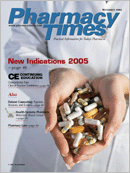Publication
Article
Pharmacy Times
Pharmacists Are Vital to the Life of a Hospital
Author(s):
The growing complexity of medicationtherapy and a "laser" focus on safety have given pharmaciststhe opportunity to play anincreasingly vital role in the hospitalsetting. At Hackensack UniversityMedical Center (HUMC) in Hackensack,NJ, one is just as likely to find apharmacist making rounds with aphysician as filling a prescription.
"As physicians realize the extensiveamount of knowledge pharmacistshave about drug use, we hear more andmore that they rely very heavily onpharmacists regarding drug usage,including identifying the appropriatedose and, in some cases, even theappropriate drug for a patient to beon," said Steven J. Aragona, MS, MBA,RPh, director of pharmacy and clinicalservices at HUMC.
"We are finding that our physiciansincreasingly realize the value of pharmacists,and, before we even add a newdrug to the formulary, it's reviewed byone of our clinical pharmacists, whoprepares and presents a monograph atthe medical center's Pharmacy andTherapeutics Committee," said Aragona.
HUMC was just ranked number 42and number 45, respectively, for heartand heart surgery and geriatrics, onU.S. News & World Report's Best Hospitals2005 list. Pharmacists areinvolved on many of the interdisciplinaryteams that plan care for suchpatients, and HUMC physicians findtheir presence to be a key element ofthe planning process. On specialtyunits, physicians benefit from sharingrounds with clinical pharmacists,whom they have described as beingwalking, talking encyclopedias of druginformation. This interaction helpspharmacists experience a more fulfillingand meaningful career path.
The process of pharmacists roundingwith physicians at HUMC started backin 1986. About 2 years ago, HUMCbegan a pilot program in which staffpharmacists were decentralized to specificareas, and the medical center isnow in the process of expanding it.
"We are initially trying to select particularareas of the hospital that willbenefit most from having a decentralizedpharmacist available and lookingat our staff to identify those pharmacistswho would be a good fit for thoseareas of interest," said Aragona. "Wehave decided on this approach ratherthan just picking someone and saying'you're going to be the pediatric pharmacist.'"
Aragona added that HUMC has notput a deadline on this process, statingthat "we want this to be a quality program,and we want to make sure wecarefully match and train our pharmacistsin the interest of patient safety."
The training of staff pharmacists isfurther enhanced by the fact that someof the HUMC clinical pharmacist positionsare joint faculty positions with theRutgers University Ernest Mario Schoolof Pharmacy. The partnership keepsHUMC on the cutting edge of pharmacyeducation. This arrangement providesan on-site source of education,and it increases the pool of availableclinical pharmacists.
Currently, HUMC has clinical pharmacistsserving the surgical intensivecare unit (ICU), the medical ICU, thecritical care unit, pediatrics, neonatology,and the emergency trauma department.Pharmacists with experience ininfectious diseases, internal medicine,and anticoagulation also serve theneeds of HUMC patients.
Keri Bicking, PharmD, BCPS, BCNSP, apharmacist in surgical critical care,trained at the Mayo Clinic, where shereceived advanced training in the ICU.Dr. Bicking said that today, as medicinebecomes more specialized, so too doesthe practice of pharmacy. Most recently,she has been working with what themedical center deems high-alert drugs,and helping to identify extra precautionsthat need to be taken concerning availability and utilization guidelines. In fact,HUMC now has increased the involvementof pharmacists in areas most likelyto use high-alert medications.
HUMC also employs what is called arapid-response team (RRT), a group ofhealth care providers called uponwhen a patient is in distress, but not ina state of emergency. The RRT was initiatedthis year in the late winter/earlyspring. Dr. Bicking said that, althoughthere is no pharmacist on the RRT yet,the medical center currently is exploringhow a clinical pharmacist can beintegrated with the team.
Another area where pharmacists areintegrating their talents is technology."One safety measure that has beeninstituted at HUMC is its computerizedphysician order entry (CPOE) system,"said Nilesh Desai, RPh, pharmacyoperations manager. CPOEeliminates the step in which a pharmacistoften has to interpret a handwrittenprescription to determinewhat the doctor has ordered. HUMC isinstituting CPOE in a stepwise approachand will build on it as the medicalstaff gains experience and confidencein using the system.
Currently, HUMC has approximately80 pharmacists, including about 60staff pharmacists, 9 clinicians, a directorof pharmacy, a pharmacy operationsmanager, a staff developmentpharmacist, and a team of pharmacysupervisors. In addition to the mainpharmacy, the campus houses 7 satellitepharmacies located in various medical/surgical and ambulatory areas.The medical center also opened aretail pharmacy at the hospital about 6months ago to expand pharmacy servicesto patients who have just beendischarged from the hospital.
"If you were to see the size of ourcampus and the number of buildingsthat need to be covered, the fact thatwe are able to deliver comprehensivepharmacy services is something we areall very proud of," said Aragona. "Weare very proud of our pharmacists andour clinical staff. They are an extraordinarygroup of professionals dedicatedto caring for our patients."
Ms. Whelan is a freelance writer based inTeaneck, NJ.







